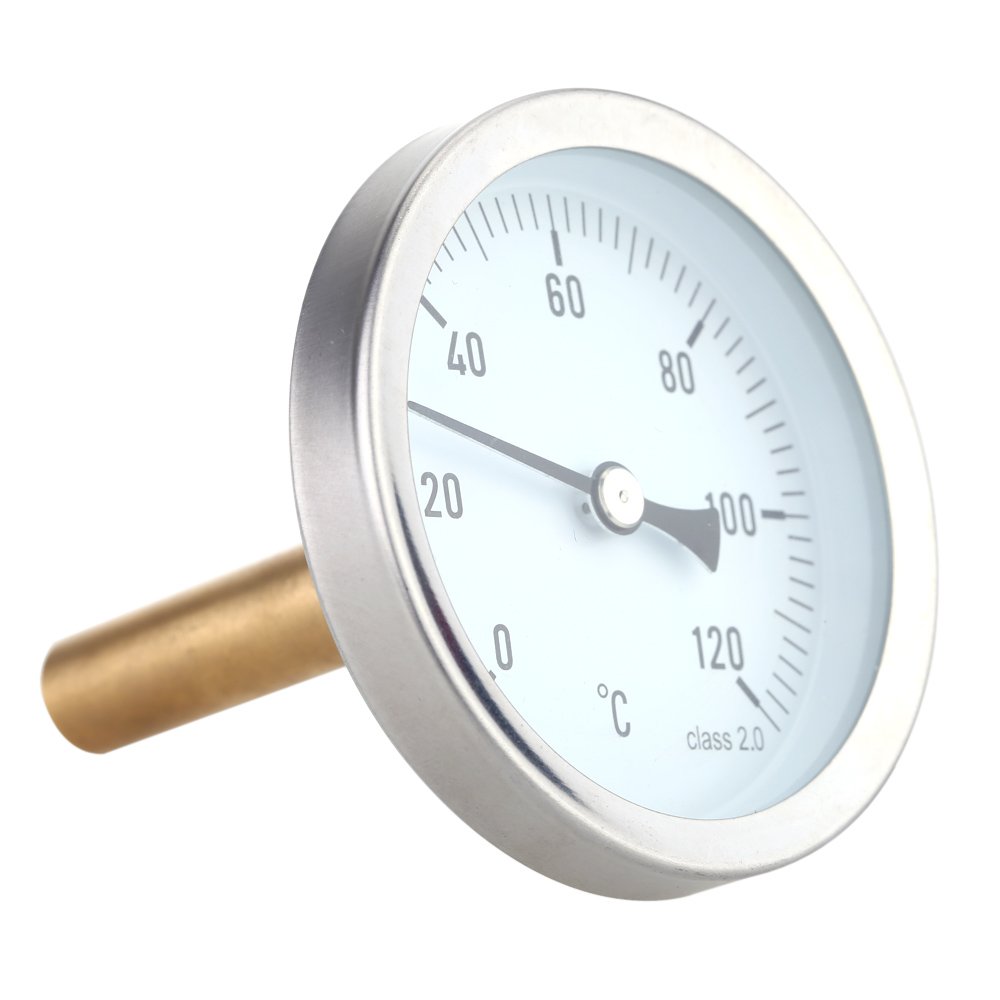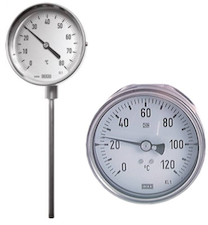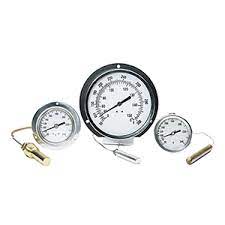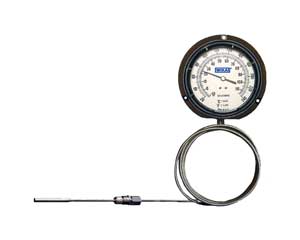Table of Contents
What is a Steam boilers Dial Temperature Gauge?
A Industrial steam boiler dial temperature gauge is a device that measures and displays the temperature of steam in a boiler. It is a critical safety device, as it can help to prevent boiler explosions and fires.
Steam boilers dial temperature gauges typically consist of a dial, a temperature sensing element, and a needle that indicates the temperature on the dial face. The temperature sensing element is typically a bimetallic strip or a liquid-filled thermometer.
The bimetallic strip is made of two different metals that expand at different rates as they heat up. As the temperature of the steam increases, the bimetallic strip bends, which moves the needle on the dial.
The liquid-filled thermometer uses a liquid, such as mercury or alcohol, to measure temperature. The liquid expands or contracts as the temperature changes, which moves the needle on the dial.
Steam boiler dial temperature gauges are typically mounted on the front of the boiler, so that the operator can easily see the temperature reading. The gauge should be calibrated regularly to ensure that it is giving accurate readings.

Types of Industrial Steam Boiler Dial Temperature Gauges
There are various types of dial temperature gauges available, each designed for specific applications. Let’s explore some of the most commonly used types:
1. Bimetallic Dial Thermometers
Bimetallic dial thermometers use the principle of thermal expansion to measure temperature. They consist of two different metals bonded together, which expand at different rates when exposed to heat. This differential expansion causes the bimetallic strip to bend, resulting in the movement of the needle on the dial.

2. Gas-Actuated Dial Thermometers
Gas-actuated dial thermometers operate on the principle of thermal expansion of gas. They contain a temperature-sensitive bulb filled with an inert gas that expands or contracts with temperature changes. The expansion or contraction of the gas causes the needle to move and indicate the temperature on the dial.

3. Vapor-Actuated Dial Thermometers
Vapor-actuated dial thermometers utilize the vapor pressure of a volatile liquid to measure temperature. These gauges consist of a temperature-sensitive bulb filled with a liquid that evaporates as the temperature rises. The resulting vapor pressure drives the movement of the needle on the dial, providing an accurate temperature reading.

Applications of Dial Temperature Gauges
Dial temperature gauges find applications across various industries due to their reliability and ease of use. Let’s explore some of the common applications where these gauges excel:
1. HVAC Systems
Dial temperature gauges play a crucial role in heating, ventilation, and air conditioning (HVAC) systems. They enable accurate temperature monitoring, ensuring optimal performance and energy efficiency.
2. Industrial Processes
In industrial settings, dial temperature gauges are utilized to monitor and control temperature in processes such as manufacturing, food processing, pharmaceutical production, and more. They help maintain the desired temperature range for efficient operations and product quality.
3. Automotive
Dial temperature gauges are essential components in automotive vehicles. They monitor the temperature of the engine, transmission, and other critical components, alerting the driver to potential overheating issues and preventing costly damage.
4. Laboratory and Scientific Research
In laboratories and scientific research facilities, dial temperature gauges are used for precise temperature measurements. They ensure accurate experimental conditions and enable researchers to obtain reliable and reproducible results.
Benefits of Dial Temperature Gauges
Dial temperature gauges offer numerous benefits that make them popular among professionals and enthusiasts alike. Let’s explore some key advantages:
1. Accuracy and Precision
Dial temperature gauges provide accurate and precise temperature measurements, allowing users to make informed decisions based on reliable data. This is essential in industries where temperature control is critical for safety, efficiency, and product quality.
2. Durability and Reliability
These gauges are built to withstand harsh environments and demanding conditions. They are designed with durable materials that can withstand temperature extremes, vibrations, and other challenges, ensuring long-lasting performance.
3. Easy Installation and Use
Dial temperature gauges are user-friendly instruments that can be easily installed and operated. They often come with clear instructions and require minimal maintenance, making them accessible to both professionals and enthusiasts.
4. Versatility
With a wide range of temperature ranges and configurations available, dial temperature gauges can be adapted to various applications. Whether you need a gauge for low or high temperature measurements, there is a suitable option available.
Dial temperature gauges are versatile instruments that provide accurate and reliable temperature measurements. With their wide range of applications and numerous benefits, they are indispensable tools in various industries and settings. Whether you’re monitoring temperatures in HVAC systems, industrial processes, automotive vehicles, or conducting scientific research, a dial temperature gauge is a valuable asset.
Investing in a high-quality dial temperature gauge ensures accurate temperature monitoring, promotes safety, enhances efficiency, and protects valuable assets. So, make sure to choose a gauge that suits your specific requirements and enjoy the benefits of precise temperature measurements.
Temperature gauge on boilers this gauge displays the boiler internal temperature. Dial temperature gauge.
Boilers Dial Temperature Gauges FAQ
A temperature gauge for a steam boiler is a device that measures the temperature of the water or steam inside the boiler. It is typically located on the front of the boiler and has a dial that shows the temperature in degrees Fahrenheit or Celsius.
The function of a temperature gauge for a Industrial Steam boiler is to monitor the temperature of the water or steam inside the boiler. This helps to ensure that the boiler is operating safely and efficiently.
To read a temperature gauge for a Steam boilers, you first need to identify the scale that the gauge is using. Most gauges use either degrees Fahrenheit or Celsius. Once you have identified the scale, you can read the temperature by matching the needle on the gauge to the corresponding number on the scale.
There are two main types of temperature gauges for Industrial boilers: dial gauges and digital gauges. Dial gauges are the most common type of temperature gauge for boilers. They have a dial with a needle that points to the temperature. Digital gauges display the temperature in a digital readout.
The main parts of a temperature gauge for a Steam boiler are the dial, the needle, the housing, and the sensor. The dial is the part of the gauge that shows the temperature. The needle points to the temperature on the dial. The housing protects the gauge from damage. The sensor is the part of the gauge that measures the temperature.
The most common problems with temperature gauges for boilers are inaccurate readings, broken needles, and leaking housings. Inaccurate readings can be caused by a faulty sensor or a problem with the gauge itself. Broken needles can be caused by physical damage to the gauge. Leaking housings can be caused by a crack in the housing or a loose connection.
If your temperature gauge is not giving accurate readings, you can troubleshoot the problem by following these steps:Check the sensor to make sure that it is not faulty.
Check the gauge itself to make sure that it is not damaged.
If the sensor and the gauge are both working properly, the problem may be with the wiring or the connections
To replace a temperature gauge for a Steam boiler, you will need to follow these steps:Turn off the boiler and allow it to cool down.
Disconnect the wiring from the old gauge.
Remove the old gauge from the boiler.
Install the new gauge and connect the wiring.
Turn on the boiler and test the new gauge.
The frequency with which you should replace a temperature gauge for a boiler depends on the age and condition of the gauge. If the gauge is old or damaged, it should be replaced as soon as possible. If the gauge is working properly, it should be replaced every 5-10 years.
You can buy a temperature gauge for a boiler at most hardware stores or online retailers. When buying a temperature gauge, make sure to choose one that is the correct size and type for your boiler.
Buy Boiler Spare Parts at the Best Price
Thermodyne Boilers supplies 100+ Industrial Boiler Parts all over India. Contact our sales team & send your requirement to get prices & discounts
